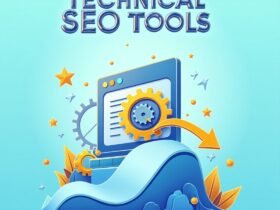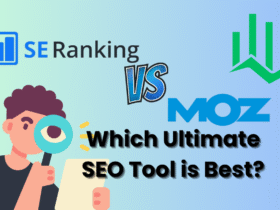Search Engine Optimization (SEO) can feel like a complicated puzzle, especially if you’re just starting out. But don’t worry—it doesn’t have to be overwhelming. At its core, SEO is about making your website easy to find, understand, and love—both for search engines like Google and for real people like you and me.
To make SEO easier to understand, let’s break it down into four main pillars. The 4 Pillars of SEO– are the foundational elements that work together to help your website rank higher in search results. Think of them as the legs of a chair—if one is weak or missing, the whole thing wobbles. But when all four are strong, your website stands tall and attracts more visitors.
The four pillars of SEO are:
- Technical SEO
- On-Page SEO
- Off-Page SEO
- Content

In this post, we’ll explore each of these pillars in detail, using simple language and practical examples. We’ll also recommend tools to help you implement these strategies effectively. By the end, you’ll have a clear understanding of how to optimize your website and make it more visible to your target audience.
Pillar 1: Technical SEO – Building a Strong Foundation
Technical SEO is all about making sure your website is built in a way that search engines can easily crawl, index, and understand. Think of it as the behind-the-scenes work that keeps your site running smoothly. If your website were a house, technical SEO would be the plumbing, wiring, and foundation—essential but not always visible.
Here are the key elements of technical SEO:
1. Website Speed
Nobody likes a slow website. If your site takes too long to load, visitors will leave before they even see your content. Search engines know this, so they prioritize fast-loading websites in their rankings.
- How to improve: Use tools like Google PageSpeed Insights or GTmetrix to check your site’s speed. Compress images using tools like TinyPNG or ImageOptim, minimize code. Also use a reliable hosting provider like SiteGround or Bluehost to speed things up.
2. Mobile-Friendliness
More than half of all web traffic comes from mobile devices. If your site isn’t optimized for mobile, you’re missing out on a huge audience.
- How to improve: Use a responsive design that automatically adjusts to different screen sizes. Test your site on multiple devices using Google’s Mobile-Friendly Test tool.
3. Secure Website (HTTPS)
Security is a big deal for both users and search engines. A secure website uses HTTPS (instead of HTTP) to encrypt data and protect user information.
- How to improve: Get an SSL certificate for your website. Most hosting providers like Let’s Encrypt offer this for free or at a low cost.
4. Crawlability
Search engines use bots (often called “crawlers” or “spiders”) to explore and index websites. If your site is hard to crawl, search engines won’t be able to understand or rank it properly.
- How to improve: Create a sitemap (a file that lists all your website’s pages) and submit it to Google Search Console. Avoid using complex code or blocking bots in your robots.txt file.
5. Site Structure
A well-organized website is easier for both users and search engines to navigate. This includes having a clear hierarchy, logical URLs, and internal links that connect related pages.
- How to improve: Use descriptive URLs (e.g., www.yoursite.com/blog/seo-tips instead of www.yoursite.com/page123). Create a navigation menu that makes it easy for visitors to find what they’re looking for. Tools like Screaming Frog SEO Spider can help you analyze and improve your site structure.
Pillar 2: On-Page SEO – Optimizing Your Content
On-page SEO focuses on optimizing individual pages to rank higher and attract more traffic. This is where you make your content shine for both search engines and readers. Think of it as decorating and organizing your house so it’s inviting and easy to explore.
Here are the key elements of on-page SEO:
1. Keywords
Keywords are the words and phrases people type into search engines when looking for information. Using the right keywords helps search engines understand what your page is about.
- How to improve: Do keyword research to find terms your audience is searching for. Use tools like Google Keyword Planner, Ubersuggest, or Ahrefs. Include keywords naturally in your content, but don’t overdo it—keyword stuffing can hurt your rankings.
2. Title Tags
The title tag is the headline that appears in search results. It’s one of the first things users see, so it needs to be clear and compelling.
- How to improve: Keep your title under 60 characters and include your main keyword. Make it descriptive and enticing to encourage clicks (e.g., “10 Easy SEO Tips for Beginners” instead of just “SEO Tips”). Use tools like Yoast SEO or Rank Math to optimize your title tags.
3. Meta Descriptions
The meta description is the short blurb that appears below the title in search results. While it doesn’t directly affect rankings, it can influence whether people click on your link.
- How to improve: Always try to write a concise, engaging meta description (under 160 characters) that includes your keyword and a call-to-action (e.g., “Learn how to improve your website’s SEO with these simple tips. Click to read more!”). Tools like Yoast SEO can help you craft effective meta descriptions.
4. Headings (H1, H2, H3, etc.)
Headings break up your content and make it easier to read. They also help search engines understand the structure of your page.
- How to improve: Use one H1 tag for your main heading (usually the title of your page). Use H2 and H3 tags for subheadings. Include keywords where appropriate, but focus on making your content easy to read. Tools like Surfer SEO can help you optimize your headings.
5. Image Optimization
Images make your content more engaging, but they can also slow down your site if they’re not optimized.
- How to improve: Compress images to reduce file size without losing quality using tools like TinyPNG or ImageOptim. Use descriptive file names and alt text so that the search engines understand what the image is about (e.g., “seo-tips-for-beginners.jpg” with alt text “Easy SEO tips for beginners”).
6. Internal Linking
Internal links are links from one page on your site to another. They help users navigate your site and show search engines how your content is connected.
- How to improve: Add links to related pages within your content. For example, if you’re writing about SEO tips, link to a more detailed guide on keyword research. Tools like Link Whisper can help you manage internal links effectively.
Pillar 3: Off-Page SEO – Building Your Reputation
Off-page SEO is all about building your website’s authority and reputation outside of your own site. This is where you show search engines that other people trust and value your content. Think of it as networking for your website.
Here are the key elements of off-page SEO:
1. Backlinks
Backlinks are links from other websites to yours. They’re like votes of confidence. The more high-quality backlinks you have, the more trustworthy your site appears to search engines.
- How to improve: Create valuable, shareable content that others want to link to. Reach out to bloggers, journalists, and industry influencers to promote your content. Avoid buying backlinks, as this can lead to penalties. Use tools like Ahrefs, SEMrush, or Moz to track and analyze your backlinks.
2. Social Signals
Social media activity doesn’t directly impact rankings. However it can indirectly boost your SEO by driving traffic and increasing visibility.
- How to improve: Share your content on social media platforms like Facebook, Twitter, and LinkedIn. Engage with your audience and encourage them to share your posts. Use tools like Buffer or Hootsuite to schedule and manage your social media posts.
3. Online Reviews
Positive reviews on platforms like Google My Business, Yelp, and industry-specific sites can improve your local SEO. It can help build trust with potential customers.
- How to improve: Ask satisfied customers to leave reviews. Respond to reviews (both positive and negative) to show that you value feedback. Use tools like ReviewTrackers to monitor and manage your online reviews.
4. Brand Mentions
Even if a website doesn’t link to you, simply mentioning your brand can boost your credibility.
- How to improve: Build relationships with journalists, bloggers, and influencers in your industry. Encourage them to mention your brand in their content. Use tools like Google Alerts or Mention to track brand mentions.
Pillar 4: Content – The Heart of SEO
Content is the most important pillar of SEO. Without high-quality content, the other pillars won’t matter much. Your content is what attracts visitors, keeps them engaged, and encourages them to take action. Think of it as the furniture, decor, and atmosphere that make your house a home.
Here are the key elements of content SEO:
1. Relevance
Your content needs to match what your audience is searching for. If it’s not relevant, visitors will leave quickly, which can hurt your rankings.
- How to improve: Research your audience’s needs and interests. Create content that answers their questions and solves their problems. Use tools like AnswerThePublic or BuzzSumo to find popular topics in your niche.
2. Quality
High-quality content is original, well-written, and provides real value. It’s not just about stuffing keywords—it’s about creating something people want to read and share.
- How to improve: Write in a clear, conversational tone. Use examples, stories, and data to make your content more engaging. Proofread for grammar and spelling errors using tools like Grammarly or Hemingway Editor.
3. Freshness
Search engines always prefer up-to-date content, especially for topics that change frequently (e.g., technology, news, or trends).
- How to improve: Regularly update your content to keep it accurate and relevant. Add new sections, update statistics, and refresh outdated information. Use tools like ContentKing to monitor changes and updates on your site.
4. Engagement
Engaging content keeps visitors on your site longer, which can improve your rankings. It also encourages social shares and backlinks.
- How to improve: Use visuals like images, videos, and infographics to make your content more appealing. Ask questions, include polls, and encourage comments to interact with your audience. Tools like Canva or Piktochart can help you create stunning visuals.
5. Length
While there’s no perfect word count, longer content tends to perform better because it provides more value and covers topics in depth.
- How to improve: Aim for at least 1,000 words for blog posts and articles. Break up long content with headings, bullet points, and visuals to make it easier to read. Use tools like Surfer SEO or Clearscope to optimize your content length and structure.
How the 4 Pillars Work Together?

SEO isn’t about focusing on just one pillar—it’s about balancing all four. Here’s how they work together:
- Technical SEO ensures your website is accessible and functional.
- On-page SEO makes your content easy to find and understand.
- Off-page SEO builds your website’s authority and reputation.
- Content attracts and engages your audience.
When all four pillars are strong, your website becomes a powerful tool for attracting visitors, building trust, and achieving your goals—whether that’s selling products, generating leads, or sharing information.
Final Thoughts
SEO doesn’t have to be complicated. By focusing on the four pillars—technical SEO, on-page SEO, off-page SEO, and content—you can create a website that’s optimized for both search engines and users. Remember, SEO is a long-term strategy, so be patient and consistent. Over time, your efforts will pay off with higher rankings, more traffic, and greater success.
Now that you understand the basics, it’s time to take action. Start by auditing your website to see where you can improve. Then, make a plan to strengthen each pillar. To know more visit the link given below-https://techsoftdigi.com/master-the-four-types-of-seo-optimize-your-site/
With a little effort and persistence, you’ll be well on your way to mastering SEO and growing your online presence. Happy optimizing!
What are The 4 Pillars of SEO?
The 4 Pillars of SEO are the core components that help improve your website’s visibility on search engines. They include on-page SEO, off-page SEO, technical SEO, and content. When these pillars work together, they enhance your site’s ability to rank higher in search engine results.
Why are The 4 Pillars of SEO important?
Each pillar plays a critical role in optimizing your website. On-page SEO ensures your content is relevant and keyword-optimized, off-page SEO focuses on building authority through backlinks, technical SEO enhances website performance, and content provides valuable information that attracts users and search engines.
3. How can I improve my website using The 4 Pillars of SEO?
To improve your website’s visibility, focus on optimizing each pillar. Ensure your pages are properly structured (on-page SEO), build quality backlinks (off-page SEO), improve website speed and mobile-friendliness (technical SEO), and create valuable, user-focused content (content pillar).
4. Which pillar of SEO is the most important?
No single pillar is more important than the others—The 4 Pillars of SEO work best when combined. However, content is often considered the foundation because search engines prioritize high-quality, relevant information.
5. How long does it take to see results from The 4 Pillars of SEO?
SEO is a long-term strategy, and results typically take 3-6 months to become noticeable. Consistently optimizing all four pillars increases your chances of achieving sustained, higher search engine rankings over time.






3 Comments